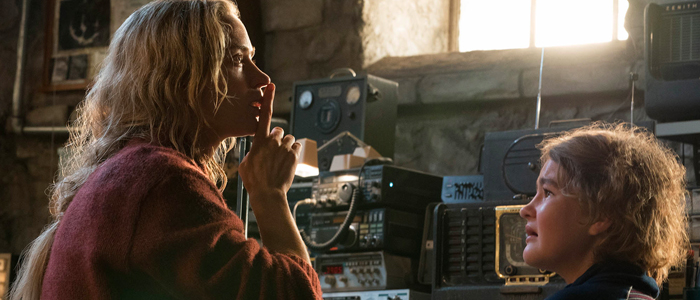‘A Quiet Place’ is a Step Forward for Disabled Characters in Hollywood Movies
As audiences become more adept at understanding misrepresentations of women, race, and sexuality, the landscape is slowly turning towards acknowledging the lack of proper representation of disabled people. More than any genre, interestingly, it is horror that has covered disability in new and unique ways.
Last year, Jordan Peele’s Get Out subtly interrogated the nuances between race and disability between its main character Chris (Daniel Kaluuya) and Stephen Root’s blind Jim Hudson. Other works, like Cult of Chucky, Hush, and the Oscar-winning The Shape of Water, have led numerous advocates with disabilities to question whether we’re moving in a positive or negative direction. As a disabled writer who’s often focused on disabled representation in cinema, I’m seeing a small crack of the glass ceiling happening, rather than a full-tilt shattering.
John Krasinski’s latest feature, A Quiet Place, is another film that makes tenuous steps toward disabled representation through the deaf character of Regan (Millicent Simmonds). Guilt-riddled over a death in the family, Regan is left isolated from her family, trapped in a world of literal quiet as well as existential alienation. Is Regan a character whose disability is just another “spidey sense?” Or is Simmonds’ portrayal, and the script that creates it, another small step towards a more inclusive look at disability?
Spoilers for A Quiet Place follow.
Silence is Survival
A Quiet Place follows the Abbotts, a family who are trying to survive in the wake of the arrival of mysterious monsters that hone in on the slightest sound. Regan, the family’s only daughter, is deaf and uses a cochlear implant that ends up being the film’s deus ex machina.
First off, it’s important to look at the use of deafness, both in the context of the film and in the history of cinema. Deafness, like blindness, is Hollywood’s go-to disability, especially for when writing about disabled women. There’s an aesthetic reason for this; beautiful Hollywood actresses can tackle the “challenge” of playing a disabled character while still retaining their power as a sex object (it’s assumed sexy and disability don’t mix). Furthermore, the removal of an essential sense, whether it be hearing or eyesight, gives audiences something they can “relate” to. Able-bodied audiences could certainly imagine what it’d be like to lack one of their five senses more than living life in a wheelchair, it’s assumed. This removal of a key sense also creates a literal manifestation of the isolation that is often assumed to be a staple of disability, shutting the character out from one facet of the world.
A Quiet Place’s script is intentionally vague on whether the Abbott family’s use of ASL is directly because of Regan’s deafness or a result of the monsters attraction to sound. Screenwriters Bryan Woods and Scott Beck stated they’d always had a deaf character in the film, but the movie never makes a direct correlation as whether the Abbotts were using ASL before the monsters’ arrival or not. The emphasis on Regan’s cochlear implant, and patriarch Lee’s (Krasinski) attempt to make it work in this new world implies that the use of ASL is something they’re reliant on more as a means of communication in their surroundings, which is a positive experience. It’s both a means of world-building and treating Regan no different than her siblings. Regardless, the film’s use of sign language doesn’t explicitly act as a means of solely communicating with Regan, although it is her primary mode of communication with her family. It is a means of integration, bonding both Regan to her family, as well as equalizing the family into a world where they must stay silent in order to survive.
“Authentic” Disability
The opening scene shows Regan walking, with her hearing device shown in her hair. It’d be worthwhile to see how the film plays had the camera shot Regan’s introduction from a different angle. Had the camera taken that same shot from the opposite side, removing the information about her deafness, the idea that ASL is a necessity for survival would be clearer. The eventual reveal of her as deaf would then compel the audience to question whether this changes how they feel towards the character, and whether the use of sign language is connected to her or not. It would have demanded the audience look at their own stereotypes of disabled characters.
Regan’s disability is never seen as a detriment. In comparison to a mobility issue, Regan is as able-bodied as can be – an additional Hollywood “benefit” of using deafness in general. Despite her hearing loss, she is portrayed as smart, able to think on her feet. In comparison to her brother Marcus (Noah Jupe), she isn’t labeled a victim. Though her malfunctioning implant prevents her from hearing the creatures behind her, her expressions are one of surprise in comparison to Jupe’s, whose reactions are strictly based in fear. Because the creatures respond to one thing – sound – there’s a leveling of strength and ability. When Marcus falls into the silo, Regan has no issue diving in after him. Regan is a hero, on par with her father, though Lee’s physical strength is no match for the creature, and thus any enhanced ability is rendered irrelevant.
Regan’s biggest character “flaw” is the guilt she feels over the death of her younger brother, Beau. When Lee says Regan must stay home with her mother, Marcus asks whether it’s because Lee blames her for Beau’s death, not because of her disability. Because of the script’s cloudiness, there’s a certain amount of debate as to whether the audience is meant to perceive Regan’s hearing loss as being a factor in her brother’s death. Had she been able to hear, would she have given Beau that noisy toy rocket? The answer is no, as it’s evident Regan knows what even the slightest sound can do. Hence her skid across the floor in the grocery store to prevent Beau from dropping the rocket. Again, it is the audience who must question themselves and their own internal ableism, not Regan as a character and the “authenticity” of her disability.
The Revolutionary Element (and a Few Failings)
A Quiet Place’s most revolutionary element is the casting of Millicent Simmonds as Regan. It’s unfortunate that the hiring of an actress with the same disability as her character is considered a rarity, but when barely 5% of disabled characters are written, and nearly 100% of them are portrayed by able-bodied actors, it’s important to highlight. Simmonds actually taught the cast how to use sign language and her ability to simply illustrate that her disability is an average part of her life is amazing, creating a character who exists on-screen because the actress understands her character off-screen. It’s another great example of why casting disabled actors is so vital.
That being said, in most dystopian features or other future-set films, people with disabilities aren’t included. This negates the ability to think about how they’d live their life in a world where technology is different or, in the case of a breakdown of society, how they’d survive. A key component of A Quiet Place is Regan’s inability to hear through her cochlear implant. As the Abbotts deal with the issues around them, from the impending birth of a new child to the chronic anxiety of remaining silent, Regan lives in a world where her ability to be one with the world is removed, not because of the monsters, but the limitations of technology in this landscape. This adds another level of anxiety, particularly for audience members with a disability. If their equipment, whether it be a hearing aid, a wheelchair, or a walker, were to break in this world, how would they fix it? This is a movie about protecting one’s children, but for disabled audiences, the movie is a horror story about caring for oneself when accessibility is all but impossible.
The film isn’t 100% able to divorce itself of ableism. Hollywood likes to fall back on making disabled people “magical,” either with heightened senses or in their possession of a skill that defeats the baddies. In this case Regan’s broken implant is the monsters’ weakness her father was searching for. Using the feedback from the implant. Regan neutralizes the monster, making them easier to kill. The concept certainly falls into the trap of being a “benefit” for her; the one thing she can do is use her disability to save the day. However, her ultimate rejection of the implant allows her to embrace the new world around her, unburden herself of her guilt, and become the new leader of the family unit.
The movie still falls into ableist thinking, but Simmonds’ strength as a performer and the film’s disinterest in making her character a disabled unicorn prior to this attempts to balance the scales.
A Quiet Place is another move towards better disabled representation. At this point, directors and screenwriters, especially in the horror genre, are more aware of characters with disabilities and thus are interested in giving them screentime. It’s clear that a future world cannot exist without acknowledging disability and A Quiet Place blends disability with a new world order that creates a balance between those with disabilities and the able-bodied. A Quiet Place’s active desire to cast an actress with disabilities is the next evolution towards representation that works.
The post ‘A Quiet Place’ is a Step Forward for Disabled Characters in Hollywood Movies appeared first on /Film.
from /Film https://ift.tt/2H88Vgj




No comments: